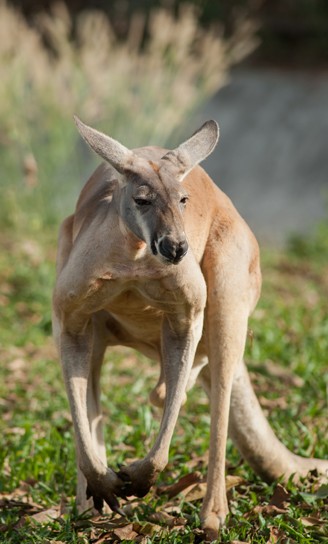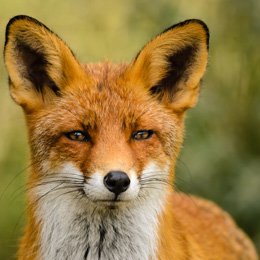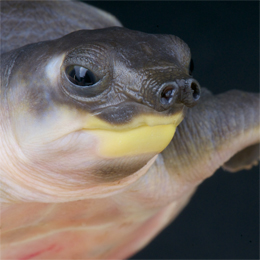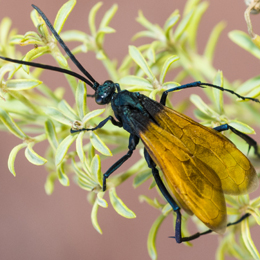Red Kangaroo
The Red Kangaroo is the largest of all existing marsupials and is found all across the Australian mainland with the exception of Southern Australia, the east coast along with the northern rainforest. As the name suggests, the body of the Red Kangaroo is covered with red furs that fade to pale buff on the limbs and down below. However, the females have a blue-gray colored coat due to which they are also called as “blue fliers”.
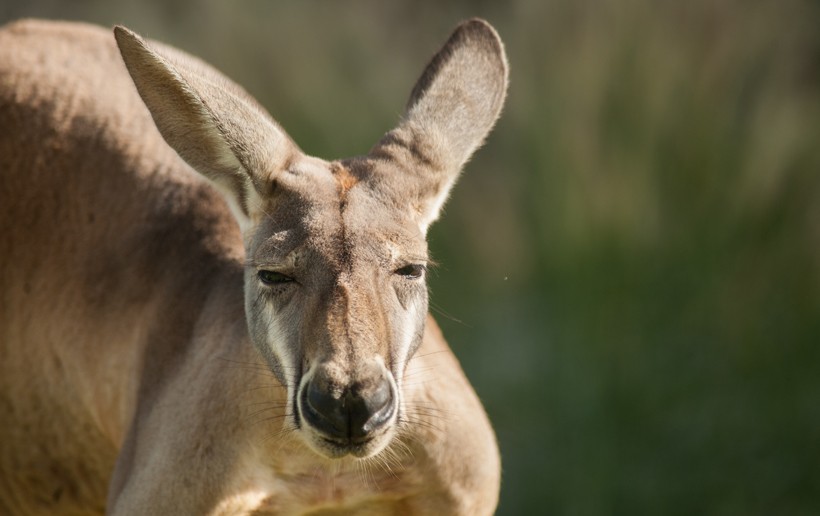
Red Kangaroo closeup head
?
Image credits: Signature Message/Shutterstock
Red Kangaroos exhibit sexual dimorphism with the males being much larger and heavier than their female counterparts. The average head-body length of the male Red Kangaroo is 1.3 – 1.6m (4.3 – 5.2 ft) with the largest recorded height being 2.1 m (6.9 ft). The weight of the males ranges from 55 to 90 kg (121 – 198 lb) and their long muscular tail can be as long as 1.2 m (3.9 ft). Female Red Kangaroos, on the other hand, have an average head-body length of 85 – 105 cm (33 – 41 inches) and a maximum tail length of 85 cm (33 inches). They are also much lighter than males with their weight ranging between 18-40 kg (40-88 lb).
Similar to other species of kangaroos, the Red Kangaroos also use hopping as their primary means of locomotion which is enabled by their long and strong hind legs. A male Red Kangaroo can cover a maximum distance of 9 meters (29.5 ft) with one single leap and can jump as high as 3 meters (9.8 ft). Though, the average jumping height is 'just' 1.2 – 1.9 m (4-6 ft). Moreover, due to the advantageous position of their eyes, the range of vision of the Red Kangaroo is approximately 300 degrees.
Relative Species
The widely popular and largest marsupial of Australia has no subspecies but is closely related to both the Eastern and Western Grey Kangaroos. However, the Red Kangaroos have a much larger and heavier body than their Grey counterpart and are also more commonly available on the mainland of Australia. The home range of the Red Kangaroo is much wider covering most of the Australian states while the home range of the Eastern Grey Kangaroo is restricted mainly to the eastern parts of Australia while the Western Grey Kangaroo inhabiting the Southern parts. Moreover, the joey (newborn kangaroo) of the Red Kangaroo stays inside their mother’s pouch for a maximum of 240 days while the pouch life of an Eastern Grey joey will be 130 – 150 days at max. However, the longest pouch life is shown by joeys of the Western Grey Kangaroos, being 550 days.
Anatomy and Characteristics
Males of the Red Kangaroo have a reddish-brown colored coat while that of the females is bluish-gray colored with a brownish tinge. However, the coat of female red kangaroos living in an arid zone is much similar to males concerning coloration. The underside of their belly, along with the lower portion of their limbs is light gray or white of coloration, whereas a dark color covers their paws and toes. The tip of their muscular tail is pale which greatly helps in distinguishing this species of kangaroo from their grey relative that exhibits dark tail tips.
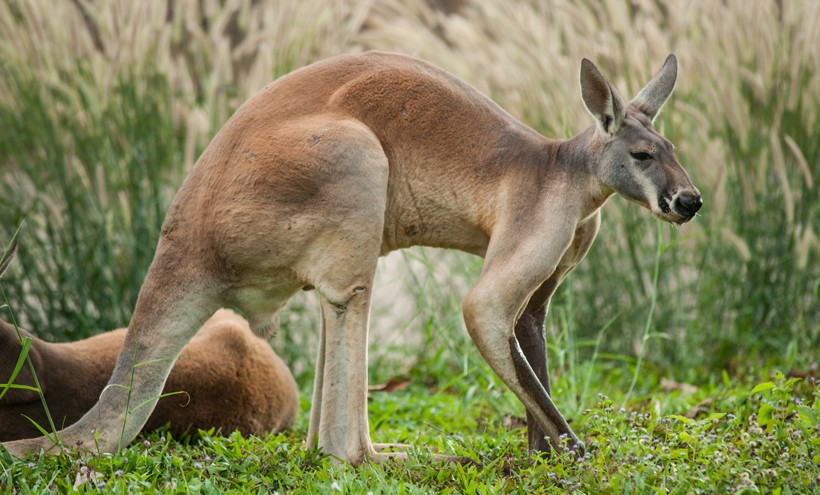
Hopping is the only form of locomotion among the Red Kangaroos
?
Image credits: Signature Message/Shutterstock
The fur of this animal is rather short but is velvety-soft to the touch. They have a squared-off muzzle which is less hairy compared to the Grey Kangaroos. The side of the muzzle is patched with black and white color and a broad stripe of white can be seen running along the cheek. The head is comparatively small but the ears are long and pointed. The two forelimbs are short and small, ending with heavily-clawed digits while the hind limbs are muscular and ideal for hopping. They have broad feet that can be as long as 45 cm (18 inches). The tail is long and muscular and is used as a counterbalance when standing upright.
Habitat
Red kangaroos mostly inhabit the dry and inland areas of central Australia. These inland areas receive an average rainfall of less than 500 mm per year and mostly include open grassland, shrubland, scrubland and desert habitats.
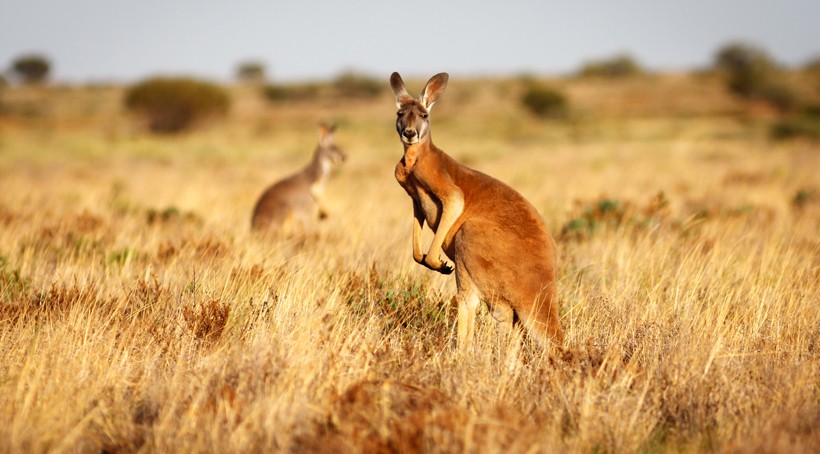
Red Kangaroo standing up in grasslands in the Australian Outback
?
Image credits: Luke Shelley/Shutterstock
Red Kangaroos prefer open habitats with scattered trees for taking shelter in the shade during hot sunny days. Their body is well adapted to live in the dry regions as these kangaroos can conserve enough water by selecting mostly fresh and green vegetation for surviving. Even their kidneys have the capacity to concentrate their urine during the hot and dry summer. Besides this, the body of a Red Kangaroo is capable of performing homeostasis that helps in maintaining their internal temperature, which rarely exceeds the point of 36 degrees celsius (97 degrees Fahrenheit).
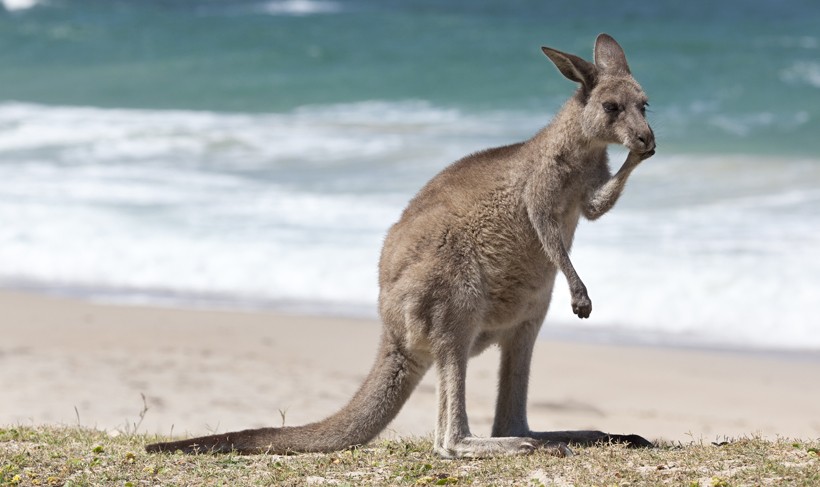
Red Kangaroo on the beach, New South Wales, Australia
?
Image credits: picture partners/Shutterstock
It is mainly enabled by various physical and behavioral adaptations that include sweating, panting and licking their forelimbs excessively during extreme heat. These animals also tend to stay in the shade and become less active when the mercury level goes up.
Diet
Red Kangaroos are primarily plant eaters with their diet mostly consisting of green grasses and a few dicotyledonous flowering plants. They are able to live without drinking water for long periods because of their ability to select and consume large amounts of succulent plants filled with moisture.
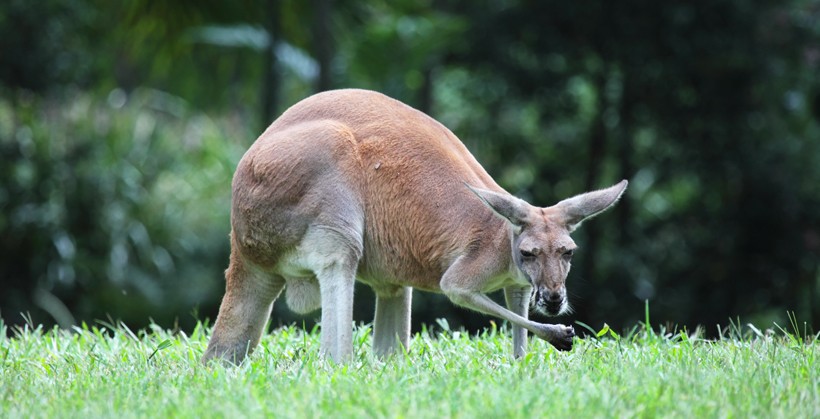
Red Kangaroo eating grasses, Queensland, Australia
?
Image credits: dirkr/Shutterstock
Even though Red Kangaroos mostly prefer to eat green grasses and forbs, they may also consume browse and shrubs during dry seasons when green plants become scarce. A study on Red Kangaroos found that fresh grasses comprise about 75 – 95 % of their entire diet with the plant species of Eragrostis setifolia covering about 54 % of their food. However, Red Kangaroos living in captivity are generally fed with beet pulp, kale, hay and grains.
Predation
As can be noticed by the large number of Red Kangaroos, they hardly face natural enemies. Their ability to kick and blow with their clawed feet and muscular legs is often effective to drive away attackers in a short time. However, joeys of Red Kangaroos often get predated by dingos and eagles when they are not guarded by their mothers. Moreover, being excellent swimmers, kangaroos often jump into the water when pursued by any predator.
Unlike today, Red Kangaroos had a number of predators living around their present habitat but went extinct due to unfavorable environmental conditions. These extinct predators were the marsupial lions, wonambi and Megalania.
Besides natural predators in the wild, kangaroos are extensively hunted and killed by humans for their skin and meat. In fact, human hunting is the major predation for the Red Kangaroos in Australia.
Reproduction and Life Cycle
Male Red Kangaroos are compelled to compete with other males for gaining mating opportunities. The larger and stronger males often establish full control over the mating of the female members in a mob by driving away other males that attempt to approach an estrus female. This competition frequently leads to a ritualized fighting behavior among the males known as “boxing” matches. During these matches, the males try to hit the others face and shoulders with their clawed forepaws and also kick at their opponent’s belly with their strong hind legs. Males and females of Red kangaroos do not show any permanent association with each other and separate shortly after breeding.
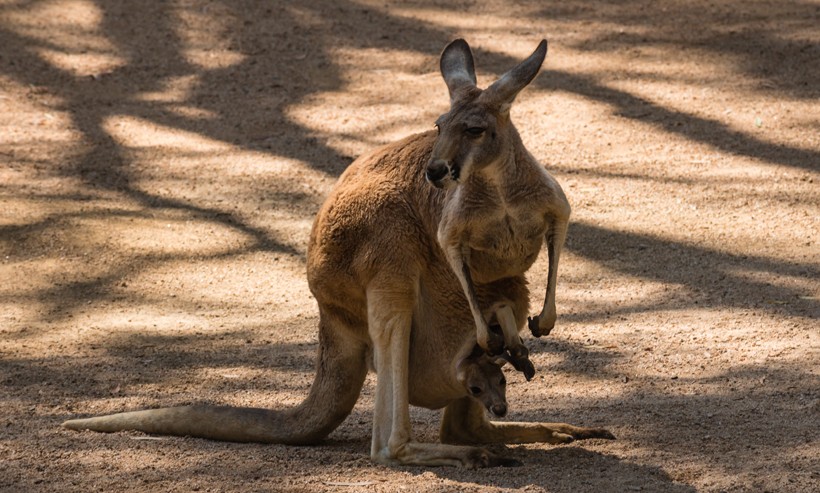
Red Kangaroo with a joey in her pouch
?
Image credits: patjo/Shutterstock
Female Red Kangaroos can breed all year round. They have a very short gestation period with a maximum of 33 days after which they give birth to a single joey. The joeys are born blind and hairless and weigh only 0.75 grams with a tiny body length of 2.5 cm. Right after birth, the young joey crawls up into the pouch of its mother from the birth canal and quickly attaches itself to one of the four nipples present inside the pouch. It remains inside the pouch for about 150 days whereafter it emerges out for short intervals. It leaves the pouch permanently after 240 days but may continue to suckle for another three to four months. Female Red Kangaroos attain sexual maturity between 15 to 20 months of age while the males become sexually mature after about 24 months depending on favorable environmental conditions.
Similar to other species of kangaroos, the females of Red Kangaroos are able to delay the birth of their young until the previous joey has finished its pouch life. This process of delaying birth is called as embryonic diapause which occurs also during periods of drought or less availability of food. Under favorable conditions, a female Red Kangaroo can produce and raise at least three joeys every two years.
On the other hand, Red Kangaroos also have a tendency to engage themselves in alloparental care. In this behavior, a female Red Kangaroo might adopt the joey of another female and bring it up as her own. This peculiar parenting behavior has also been observed among other animals like elephants, wolves and fathead minnows.
Behavior, Communication and Intelligence
Red Kangaroos usually live in small groups consisting of 2 – 4 individuals. But in areas with abundant forage, Red Kangaroos can congregate to form enormous groups consisting as many as 1,500 individuals. The most common group of these large marsupials comprises of females and their joeys. Larger groups are mostly formed in areas with a thick population of kangaroos where males can also be seen living among the group.
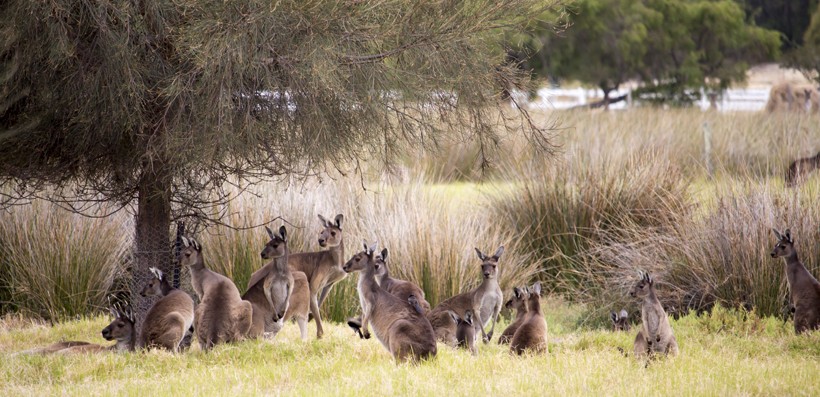
Red kangaroo mob grazing in a green grassy paddock
?
Image credits: CrystalView/Shutterstock
Group members do not show any strong attachment with each other and membership can be very flexible. The males, also known as boomers, are not territorial and fight only over females that have come into estrus. Young males exhibit agonistic interaction with each other by engaging in ritualized fighting, known as boxing.
During these ritualized fightings, the males try to push away their opponents by locking the forearms. They also kick each other on the belly with their strong hind legs while supporting their entire weight on the muscular tail. Compared to the fights between other species of kangaroos, the fights between males of Red Kangaroos involve more wrestling. The winner of these fights becomes the dominant male and enjoys the exclusive access to sexually mature females. An alpha male will continue to make agonistic behavior until another male overthrows him by defeating him in a ritualized fighting. The displaced male then leads a solitary life by avoiding close contacts with other kangaroos.
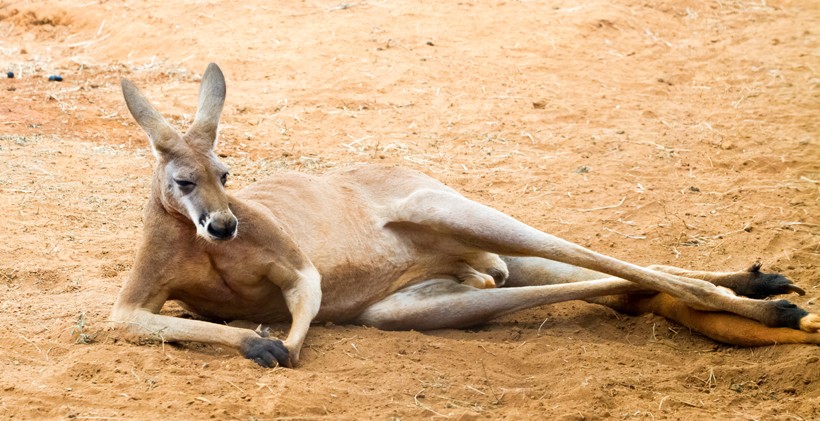
Red Kangaroo resting
?
Image credits: Anky/Shutterstock
Red kangaroos are nocturnal animals that spend most of the daylight hours by resting in the shade. On rare occasions, they can be seen moving around and foraging during the day. In extreme heat, these animals take shelter within the mulga bushes or small saltbushes available within their habitat instead of the cave or rocky outcrops.
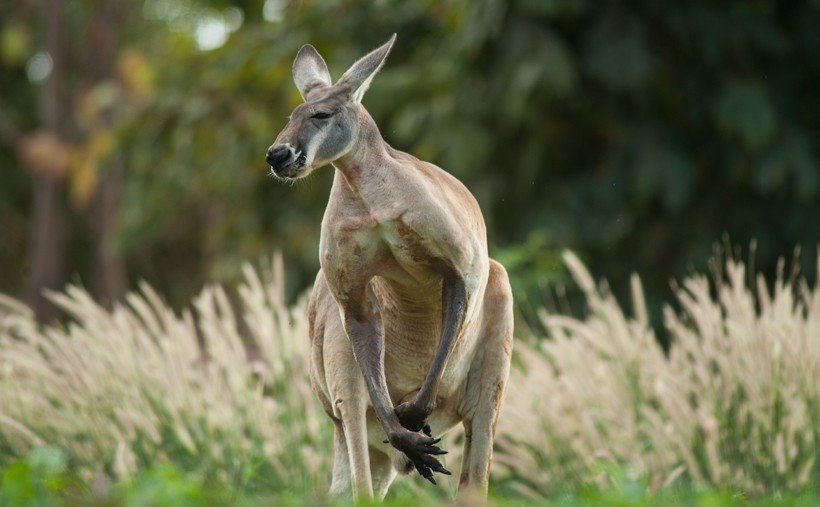
Red Kangaroos spend most of their time grazing
?
Image credits: Signature Message/Shutterstock
They spend most of their time grazing in the open plains and stay within a specific and well-defined home range. However, in response to rough environmental conditions, this large species of kangaroo may travel long distances of about 25 – 30 km in search for favorable habitats. A study carried out on the Red Kangaroos of Central Australia revealed that when the forage becomes poor they would often stay close to the remaining vegetation and disperse in search of fresh plants only after it rains. Red Kangaroos found on mainland New South Wales have a home range as large as 560 hectares with the adult males covering the largest areas.
There is little information available regarding the methods of communication among this kangaroo species. Similar to other animals, the Red Kangaroos are likely to depend on the use of chemicals for communication and perception. Considering their excellent vision and keen sense of hearing, these marsupials also rely on these powerful sensory organs for communication.
Population and conservation status
The species of Red Kangaroo is not considered as an endangered species. Due to its wide distribution and large population all across the Australian mainland, the Red Kangaroos are classified as Least Concern on the Red List of IUCN. This species is not subjected to any kind of major threat and all states of Australia strictly regulate the commercial hunting of Red Kangaroos. Moreover, the rapid spread of agriculture combined with the creation of artificial water sources for the increasing livestock in Australia has provided considerable advantage to the population of these large kangaroos. In fact, the population of Red Kangaroos is so large that it is considered as a pest around agricultural lands and is extensively hunted under license for their meat and hide.
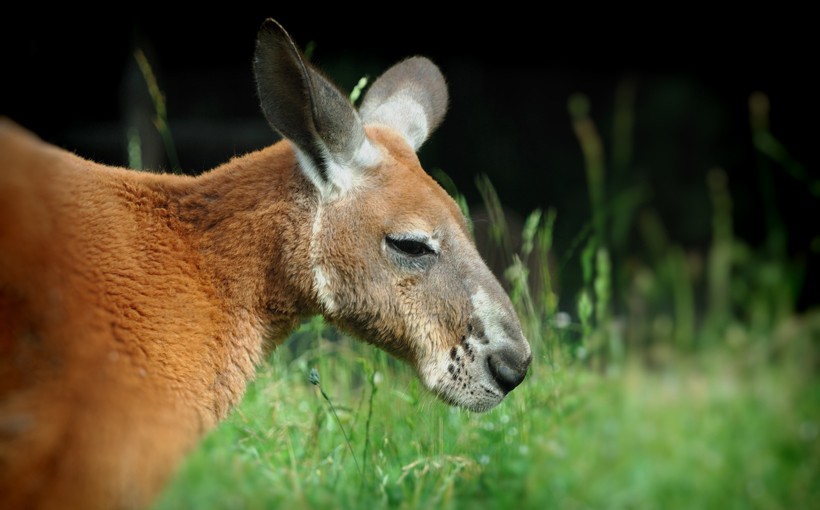
Red Kangaroo close up
?
Image credits: Pavlo Burdyak/Shutterstock
The hunting permits and the commercial harvesting of Red Kangaroos are controlled by a number of management plans that helps in maintaining the population of these animals and also makes efforts in minimizing the agricultural damage made by the kangaroos. In addition to this, aerial surveys are carried out regularly to monitor the population and distribution of these kangaroos all over Australia.
Cultural Depiction
The Red kangaroo is one of the most instantly recognizable species of Kangaroo in Australia and is often considered as a symbol of this continental nation. The images of kangaroos adorn the coat-of-arms, postage stamps and coins of Australia. Even the major international airline of this country uses the image of kangaroo as their prime symbol. The wide scale distribution combined with the large population of kangaroo has made this animal the icon of Australia.
Evolutionary History
The Red Kangaroo is one of the most recently evolved species of kangaroo in Australia. Kangaroos and Wallabies are two closely related species that have been roaming on the planet for about 30 million years. By comparing the skeleton of about 35 macropod species, both living and extinct, it has been found that the earlier forms of macropod species were more adapted to the diet of soft-leaved plants found in rainforests while the later form of macropods showed signs of adaption to an arid condition. Besides the diet, the later form of macropods also showed rapid evolution in the foot anatomy that reflects the beginning of the extraordinary leaping ability of the present-day kangaroos. This evolution of the kangaroo is also a clear evidence of the historical climate change that took place in Australia and replaced the earlier thick rainforest with the large scale open grass- and scrublands.
Funfacts
- Red kangaroos are the largest of all kangaroo-species found in Australia.
- The males of Red Kangaroos are much larger and heavier than the females.
- The largest Red Kangaroo recorded so far is an adult male with a height of 2.1 meter (6.9 ft) and a weight of 91 kg (201 lb).
- Although known as Red Kangaroos, the females of this species have a Bluish-gray colored coat with a slight brownish tinge.
- The range of vision of Red Kangaroos is almost 300 degrees.
- The Red Kangaroos are able to jump as high as 1.8-3 meter (6-10 ft) while covering a distance of 9 meter (30 ft).
- The Red Kangaroos are able to survive without water for many days.
- The females of Red Kangaroos are capable of embryonic diapause in which they intentionally delay the birth of their young ones.
- Red Kangaroos are excellent swimmers and often jump into water for evading their predators.
- Hopping is the only form of locomotion among the Red Kangaroos.
- The ritualized fighting of the Red Kangaroo is also called as boxing due to its close resemblance to the boxing game.
